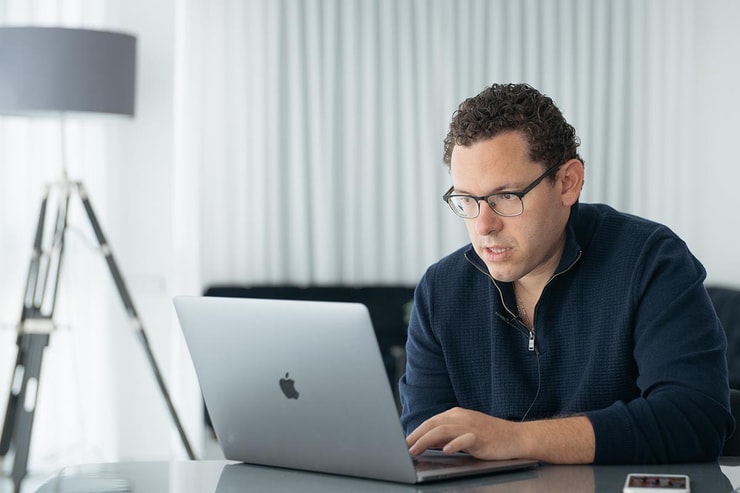There’s something you must do after every single trade. What is it?
Always review your trades — and other people’s trades. Here, I’ll show you exactly how my students and I use trade analysis to help us trade smarter…
My Trading Challenge students get it. And they continue to do the best of all my students.
It’s because they have access to all the video lessons, DVDs, and especially the webinars. Nobody else gets access to all the webinars.
But it’s also because they break down every trade.
Table of Contents
How to Analyze Your Trades

Most people know that my go-to is Profit.ly. I created it for traders to share every single trade. I also did it to add transparency to this industry that’s full of fakes. And traders can use it to track and verify every trade.
There are so many fakes who love to lure in newbies with big claims of epic gains. I don’t want to see month-end or year-end BS statements. I don’t want to see a screenshot of some big gain.
I want to see EVERY trade. Sharing losses and being honest with yourself — and an entire trading community — can be a key way to improve.
It’s not a coincidence that Profit.ly isn’t as popular as it should be. People don’t want to show the ugly side of trading. For example, when they screw up or take big losses. But it’s real.
Profit.ly tracks every trade. It also calculates statistics for you. Enter your entry and exit price, the number of shares you traded, and your thoughts on the trade … Profit.ly does the rest.
You can see your win and loss percentage, an average dollar and percent gain, and your win-to-loss ratio.
It also tracks other statistics you might not even think of … Like your biggest win compared to your biggest loss or your max consecutive days of wins and losses. You can even check your win rate by day or month.
So maybe you’re terrible at trading on Mondays. If you know the stats, you can stop trading that day. Or figure out why and do something about it. Or you can use that day to study instead.
Review your past trades regularly. Yeah, you could do this all by hand … But trading is hard enough.
More Reasons to Track
When I share my trades on Profit.ly, I include entry and exit comments and my goals for the trade. All my trades go out to subscribers as real-time alerts.
I analyze my trades by creating video lessons. I go over my recent trades and review what I did wrong and right. Sometimes talking through the trade out loud can give me more insight into my thought process.
Some of my top students create video lessons and trade recaps too. One of my top students, Mark Croock,* recently posted a lesson about the importance of reviewing trades, especially when you’re in a slump.
He had some recent losses. But he turned it around by analyzing what he was doing wrong. He was losing discipline, forcing trades, and getting bad entries due to being impatient.
Needless to say, you can learn a lot by studying what my top students and I do, but what’s happening with YOUR trades?
More Breaking News
- Top Bitcoin Stocks to Watch Under “Crypto Emperor Trump”
- BigBear.ai’s Journey in the Stock Market: Rising Trends and Challenges
If you’re struggling with your trading, first, ask yourself this…
What Are You Good At?

My answer probably won’t surprise you here…
You need to go back and review your trades.
This is what every top student does. They analyze every trade. It’s critical to being a self-sufficient trader.
You have to keep a record of every trade you take. Even if you’re just paper trading. That’s how you figure out where you excel.
If you want to find consistency, you need to know what setups work for you … and then stick to those setups. Refine your process and stick to what works. It’s not the same for every trader.
You never fail at trading until you actually quit so learn to take small losses, refine your process & win more consistently over time
— Timothy Sykes (@timothysykes) February 13, 2020
So how do you find out what you’re good at?
Try Different Strategies
There’s no one right way to trade … The important thing is to keep learning. Always.
All of my most successful students tried different things and had losses in the beginning. And some of those losses were big…
Tim Grittani blew up his first $1,500 account. He’s now closing in on close to $10 million.* Sometimes the key to success is to lose at first. That way you learn what not to do.
It’s rare for traders to find success early on. If they do, it may be because of luck. They hit the right sector at the right time. But too often they learn the wrong lessons.
Maybe they started out when there was a hot sector, like Bitcoin or pot stocks. They get used to having stocks in play every day. Then when the hot sector’s gone, they give back all their gains by overtrading.
You can’t rush the learning curve. And you can learn a lot from your losses. Losing small can be key to learning what not to do.
Your only goal should be to find what works for you and what makes sense to you.
And throughout your career — from day one until your last trade — you’ve gotta…
Keep a Trading Journal
Track every single trade in a trading journal. How you track those trades is up to you. It can be via Profit.ly, a spreadsheet, a notebook, an online doc, etc.
Track everything. Your trade thesis, your entry and exit, and the pattern you were trading. Was the trade a win or a loss? What was your mood? What time was it? What went right or wrong?
It may sound like a lot … but it can help you understand your own patterns and rhythms. You can start to understand what really works. It’s all part of the process of learning to trade.
Don’t trade like a degenerate gambler.
If you don’t know what pattern you’re trading — you’re gambling. Stick to patterns you can identify. It can make it easier to figure out which ones suit you.
Turning Losses Around

Top students can help turn their losses around by analyzing what they do wrong. Some take heavy losses when they’re new to the markets. It’s a process and it takes time.
Not everyone has the patience to stick it out. Some whine and complain or blame penny stocks and my strategy…
Most traders lose because they lack discipline and they don’t prepare.
Maybe they chase too much. Or they ignore rule #1 and don’t cut losses quickly.
That’s why I tell new students it takes time and dedication to succeed … and a lot of studying. Don’t start trading thinking it’s easy money…
You will lose sometimes. Every trader does. Let’s look at an example…
My student Kyle reports being up $140K.* In the beginning, he reports he was down about $20K.
When he started turning his losses around, he started over with a new Profit.ly account. You can check out Kyle’s profit chart here.
Some people might think he’s not being transparent by deleting his old account. But he’s not trying to hide his losses. In his mind, he needed a fresh start.
You can do whatever works for you. I want students to learn and find consistency. But it takes time and dedication.
Learn from your mistakes. And remember, it’s a marathon, not a sprint.
Let’s look at a recent trade so you can see how it works…
Lessons From a Recent Trade
Here’s an example of how I analyze and learn from my trades … Recently I took a small loss on CytoDyn Inc. (OTCQB: CYDY). I was trying to dip buy a morning panic, but I was early.
Eventually it did bounce — 40%. I’m not saying I would have held for the full 40% even if I timed it well. But I was on the right track.
Here’s where analyzing trades is so important…
Trading Is More Than Wins and Losses
Frankly, I kinda forced the CYDY trade. I was giving a live webinar. I wanted to be the hero…
I know I shouldn’t think that way. I know I should have patience. And I always tell students to wait for the trade to come to them.
In my defense, I was trading from Japan. It’s not my favorite time-zone. (It’s actually one of my least favorites.) I was tired, giving a live webinar and…
… it was a third red day for the stock.
Typically, the panic on the third red day is weak. So when it showed signs of bouncing, I bought thinking it might go red to green on the day. That wouldn’t be a huge bounce, but enough to be a profitable trade.
But in this case, it turned out to be the biggest panic. I bought WAY too early and the initial bounce was weak.
I sold half my shares for a small profit. So there was an opportunity to make money but I took too big of a position. I couldn’t get out of the other half. And as it kept falling I chased it down.
As I often say…
You Get Bloody Trying to Catch a Falling Knife
When it did bounce later, I didn’t want to get back in after taking a loss. It just shows you how losses can affect your mentality. So I learned my lesson. I rushed it. I should have waited for the trade to come to me.
After my loss, I made a video lesson to analyze the trade. It helps me to review my trades with my students. And if I can help students avoid these mistakes, it’s a win for me.
A lot of my students, including Jackaroo and Mark Croock, caught the bigger bounce.* Congrats to them. I love to see students trade better than I do!
Conclusion: Learn From Successful Traders

I encourage all new students to look through the verified trades of the top students on Profit.ly. Read the comments to understand the reasons for the trades and why they did or didn’t work.
Then hone everything you learn into your own strategy that you can rinse and repeat. It’s not easy and it takes time. You can’t rush it. If you do, you’ll probably screw it up.
Join my Trading Challenge to learn how you can be a better trader. Get access to all my video lessons and DVDs. And the webinars. It’s a great way to learn from top traders…
There are over 1,000 archived webinars by me and my top students. You can learn from traders like Tim Lento, Mark Croock, Tim Grittani, and Michael Goode. The webinars can be incredibly useful, whether they’re live trading or Q&A.
Trading is not an exact science. You have to find what works for you. But you can learn from other traders’ journeys.
[*Note that these results aren’t typical. These students put in the time and dedication and have exceptional skills and knowledge. Most traders lose money. Always remember trading is risky … never risk more than you can afford.]
Be honest … Would you stick with trading if you had HUGE losses at the beginning? Leave a comment and share your thoughts!




Leave a reply